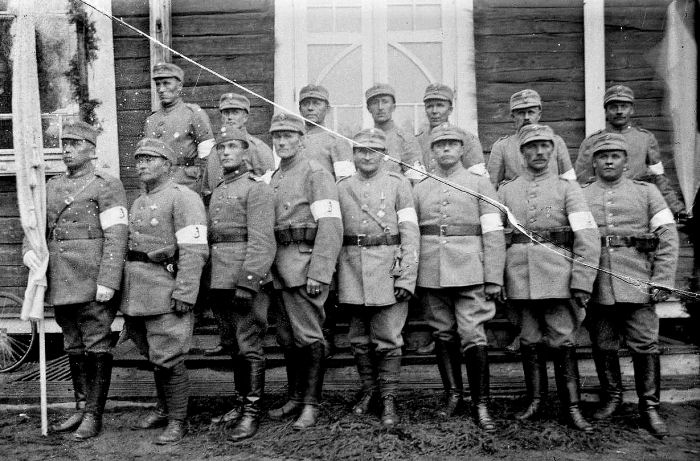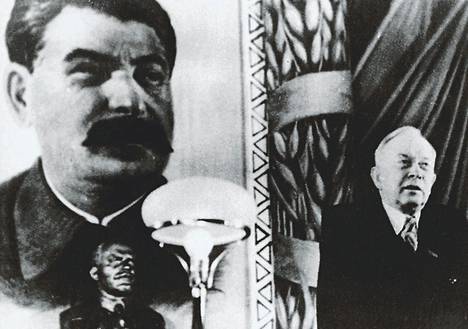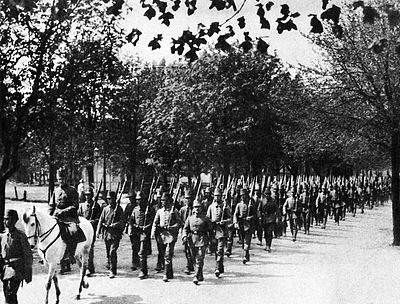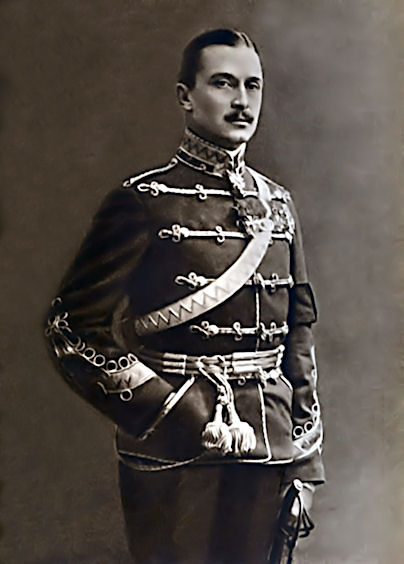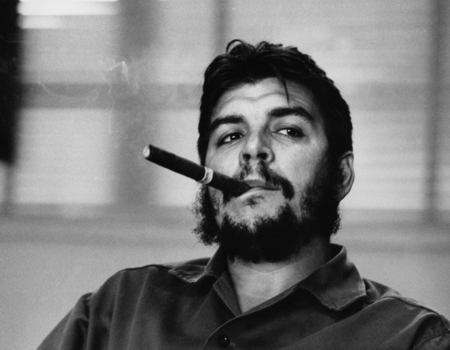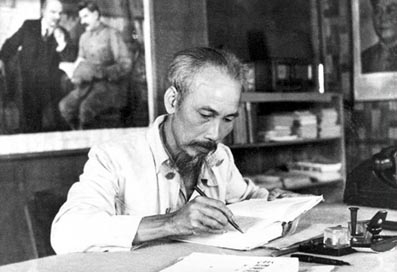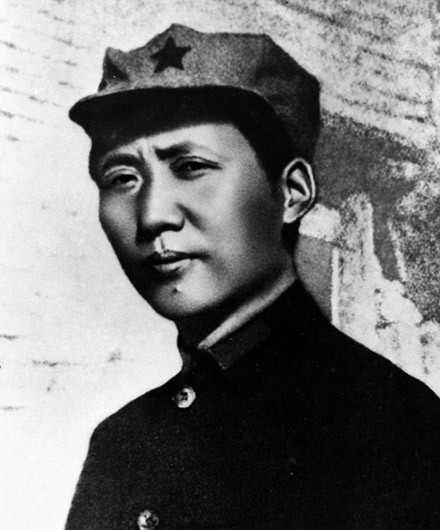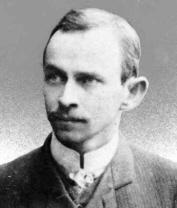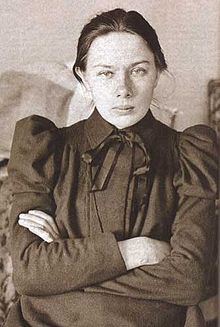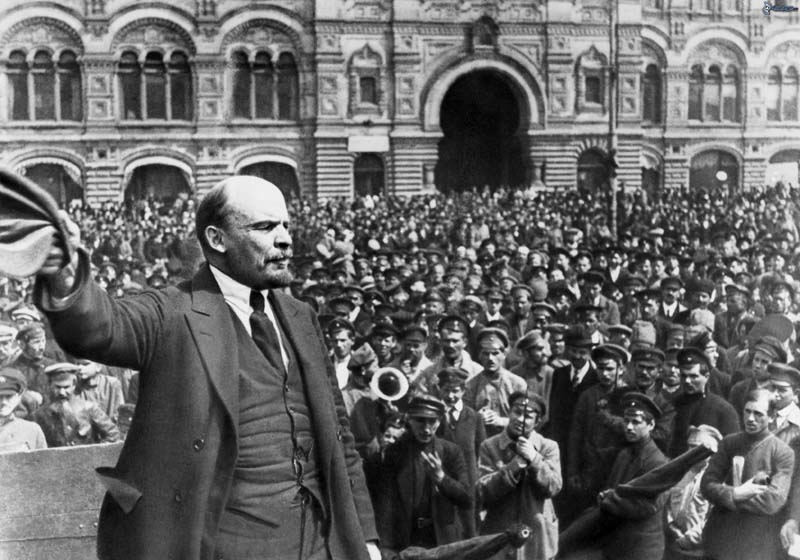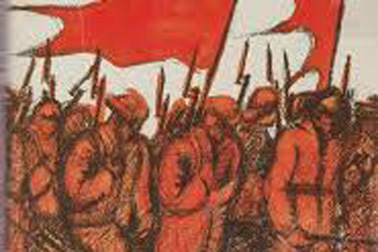
“That flammable substance, which in January 1918 burst into full flame of armed conflict between the basic classes of Finnish society – workers and capitalists, had been accumulating for decades in the depths of this system. With the rise of capitalistic production, here too the struggle between labour and capital, between worker and capitalist, became the basic contradiction of the whole society. Unjust relations of landownership and the utterly vulnerable status of the vast masses of landless rural people, had created a situation where the capitalists had plenty of very cheap labour at their disposal. Finnish capitalists took full advantage of the situation and wasted no time in setting up a system just as ruthless and unequal as that of the older capitalist countries. The situation was even more favorable for the capitalist class because the workers were at this time timid, scared and did not attempt any kind of organized resistance. Instead they suffered the oppression and injusticy quietly, and this way the bitterness and anger slowly built up among them.” (Tuure Lehen, Punaisten ja Valkoisten Sota p. 9)
Different social classes before the outbreak of the revolution:
The Industrial Workers:
“In the old system workers had needed to submit to the ‘legal guardianship’ of their employer, which often meant police levels of surveillance and control by the capitalist. This was officially abolished in 1868 but employers still for a long time considered it justified to continue their old ways. The strict work discipline regulations allowed the employers in many ways to blackmail their workers, punish them for the slightest disobedience, or carelessness, impose heavy fines and thus push down the already meager wages. The employers were especially worried about worker’s organizing, unless they were joining organizations and associations created and controlled by the employers themselves. It was common for capitalists to threaten to fire all workers who joined unions or worker organizations. This happened for example in Pinjaiset, Fiskars and Högfors factories. In November 1903 in Varkaus nearly 200 workers were evicted from their homes for joining the workers’ association. Often buying or subscribing to working class newspapers was enough of a reason to be fired and evicted.” (Lehen, pp. 9-10)
“Despite rapid industrial development having begun in the 1860s it was as late as the 1890s when the country saw the breakout of the first big strike movements. Out of these the strikes of construction workers in Helsinki in 1896 and the baker strike of 1899 have to be mentioned. In both cases the Finnish capitalists shamelessly colluded with the Russian authorities to break the strike: by sending in strike breakers from Russia. In these initial strikes, alongside the struggle for higher wages, the demands centered around shortening the working day which was either unbearable long, or not limited at all in its length, as well as demands for the most basic work safety regulations. During this struggle based on the most vitally necessary demands, the class consciousness of the workers began to awaken. This caused worry among the capitalists, who saw the mass mobilization of the workers as a sign that the workers were turning to revolutionary socialism…
A sign of this worry was the capitalists’ attempt to push the workers towards wrightism, a reformist tendency lead by the bourgeoisie, which told the workers to remain calm and “not demand too much”. Eventually the workers got tired of wrightism, as the experience of their every day lives quickly taught them that improvements in their lives, were never gained by begging and surrendering, but only by forcing the capitalists into granting the workers’ demands.
For this reason the workers turned their backs on wrightism and began more boldly to support the Socialists who expressed the will to directly tackle social inequality, and put forward concrete demands instead of pious wishes. Strenghtening of these sentiments led in 1899 to the creation of the Finnish Workers’ Party… which declared a “split from the bourgeoisie”. (Lehen, pp. 10-11)
“The founding of an independent workers’ party had a crucial significance to the working class and it proved to be a powerful catalyst in favor of developing mass mobilization. An increasing determination and steadfastness was becoming evident in the workers’ struggle.
The struggle took fairly intense forms in 1904 in Voikkaa where the conduct of a foreman sparked the anger of the workers and caused a strike. The employers called in the Finnish-Russian authorities who sent a gang of police to crush the strike. The police arrested the labour leaders and evicted from company apartments the workers who had been fired for participating in the strike.
In 1905 and 1906 there were several strikes that lasted for several weeks, even months. The metal workers’ strike, which consisted of 3000 workers lasted for 19 weeks. The construction workers were able through their disciplined struggle to win a 9-hour working day.
The strike that proved most significant was the logger strike of the Kemi-company in North, which began on logging sites in Kuolajärvi and Sodankylä and spread to Kemi, and which lasted consecutively almost the entire year 1906. The great single-minded determination and discipline of the workers was demonstrated by the fact that out of the 3000 strikers, during the entire year only couple dozen became strike breakers. The most immediate cause of the strike was that the Kemi-company had taken for itself a monopoly on selling food to the workers, had forced the workers to only purchase food from the company store at very high prices, or risk being fired. The food also proved to be dangerously rotten and unfit for human consumption but the employers had arrogantly ignored the workers’ complaints. The workers demanded that the company must sell them only clean and edible foodstuffs. Along with this the workers demanded a shortening of the work day to 10 hours per day, an increase in wages, and the abolition of the blacklist system.
Not agreeing to the workers’ demands the Kemi-company together with the authorities took action to stop the “rebellion”. It closed down the food shops trying to starve the workers into submission. As the company owned all the food stores, the workers had no other option to avoid starvation then to break open the doors of the food shops and organize food distribution to the starving, which was done according to proper payment and under strict observation. The employers asked for help from the authorities… a gang of 35 lead by police liutenant Bruno Jalander was sent to “pacify” the workers of the North. Tens of workers were arrested, around twenty involved in opening the food shops were sentenced for robbery and blasphemy[sic] to varying prison sentences.”
(Lehen, pp. 11-12)
The Workers’ Party
“The success that the workers’ party gained already in its first parliament elections showed clearly that the party had not only gained the uninamous support of the industrial workers, but it had also won a large amount of votes from among the rural population. A contributing factor was that the workers themselves had close contacts to the countryside and the rural poor. Members of the working class were generally speaking young people, only recently left from the countryside to the cities. The poor position of the rural population also naturally brought it close to the working class movement to seek support from it.” (Lehen, p.15)
“The experiences gained in these labour struggles explain at least in part the often pointed out fact that the Finnish working class movement was already early on very interested in struggle for state power, while trade union organizing lagged behind the political struggle for many years. The independent Finnish workers’ party founded in 1899 had to for several years also perform the duties of a central trade union organization, especially during large strikes because the Finnish Trade Union Federation was founded only in 1907.
The active involvement of the state authorities, the police, court system and state church into the disputes between workers and capitalists always on the side of the capitalists, gave rise to anger by the workers towards the reactionary state authority. The close connection of the Finnish representatives of that state apparatus to the Russian tsarist ruling class, whose repressive actions always first and foremost targeted the workers and their organizations, makes it easy to understand why workers had such an exemplary role to play in the indipendence struggle…” (Lehen, p 13)
“The rapid rise of the independent Finnish political workers’ movement culminated in the December 1905 general strike, a mass action of unprecendented size for equal municipal suffrage and to destroy the old feudal system that had resisted all social progress.” (Lehen, pp. 13-14)
The Tenant Farmers
“The most important social grouping were the tenant farmers, who cultivated the land they rented from the nobles, large landowners and capitalist corporations. In the relations between tenant farmers and landowners the essential question was that of terms of rent. In individual cases, such as when tenants would rent land from relatives, the terms could be quite tolerable… The general picture however was something different: a relationship of extreme exploitation and oppression where the position of the tenant was similar to that of a medieval serf. The rent payment in the form of a work-tax i.e. working on the landowner’s land weighed heavily on the tenants. The payment was not merely a reasonable or justifiable compensation for the use of land, but ruthless exploitation…” (Lehen, p.16)
The landlords would often cheat the peasants in rent terms. Most of the time there were no actual written contracts but rent was decided simply in verbal agreement. And of course most of the peasantry were illiterate.
“Another important grievance in the life of the tenants was the uncertainty of their situation. The terms of the rent were usually decided in oral agreement between the two parties. In the cases where written contracts were made, they were always vague and up for interpretation, and it didn’t benefit the tenant to appeal to the legal authorities since it was obvious that “law and justice” were on the side of the aristocrats, corporations and landowners. The violent and ruthless mass eviction of the tenant farmers of the Laukko manor house by the armed force of the “legal authorities” in May 1907 is an illustrative example of how the society of that time saw it as the noble lord’s sacred right, to treat his subjects how ever inhumanly as he saw fit.” (Lehen, p.16)
“The broken down doors and hearths of the cottages of the manors’ tenants, served as a metaphor for the dead end that the oppressed classes found themselves in: they had to do something to improve their lives, yet their attempts were met with even worse suffering.” (Y. Kallinen, Hälinää ja hiljaisuutta, p. 26)
A common practice by the landlords was to let a tenant family move to an area where the land was of poor quality (this could be e.g. a bog, a swamp or forest) then let the peasant family improve the land (drain the swamp, chop down the trees etc.) so they could turn it into a farm. Then after the rent contract ran out, the landlord would evict the peasant and thus acquire the newly created good quality farm land for themselves. The peasant family would then be forced to move to another bad piece of land and repeat the process.
“For the tenant farmers the threat of eviction was always there, and it was an effective method of blackmail. It was used especially when the landowner wished to acquire a piece of land which the tenant had through their productive labour turned from a wasteland to fertile farmland.” (Lehen, p.17)
“…I met several tenant farmers who had been evicted, often even multiple times and each time had had to once again clear a new farming plot into a thicket or a bog on the property of the same landowner… I met an old man who had sat years in jail for resisting the crown’s police when they came to evict him for the third time… It was clear that people in this position were eager to hear and accept the socialist teachings, as it gave them an explanation about their own societal position and a path to follow towards liberation”
(M. Ampuja, Pajasta parlamenttiin, Turku 1947, p.73)
“… the pitiless violence the landowners had to use against their tenants was a sign of the rising class consciousness of the tenant farmers, who due to circumstance could only see the socialist movement as the strongest defender of their rights.” (Lehen, p.17)
“In those days, the tenant farmers of Finland had begun to follow the example of the industrial proletarians and had started mass organizing for their rights. In various parts of the country there were mass meetings, also strikes, the demands of which were mainly protections against evictions and against the arbitrary and absolute power of the landowners. The Workers’ Party gave its immediate support to the demands of the tenant farmers and other rural poor. It also helped them to organize their struggle. The Party leadership played an importan part in helping to organize the first nationwide congress of tenant farmers’ deputees in Tampere in 1906. The fact that 50.000-60.000 tenants out of a total of hundred thousand had representatives in this meeting was a clear sign of the desire of the farmers to fight side by side with the workers.” (Lehen, p.18)
Servants and Farm Workers: The Rural Proletariat
“The societal situation of [the house servants and farmhands] was even more oppressed and precarious then that of the tenant farmers.” (Lehen, p.18)
“Servants, who lived in spare rooms of houses [of their employer] or in cottages under severe surveillance… were not allowed to leave the house without the permission of their master, or to talk to outsiders. As the status of tenant farmers has often been compared to that of serfs or semi-slaves, that of the servants could rightly be compared to full blown slavery… An 1865 servant law which was only taken off the law books in 1920… gave the master of the servant the right to the most petty kind of spying, ruthless exploitation, inhuman treatment and even physical violence. The servant was not allowed to own a locked chest or a bag, all their belongings had to be visible for inspection by their master. The length of the working day was unlimited. Unlike the old slave owners, the master was not allowed to kill their servant, but he was allowed to hit them. According to the 3. article of the servant law, the master was allowed to physically punish female servants under 13 and male servants under 18 if they didn’t adequately fulfill the tasks their master thought “reasonable”, which according to Miina Sillanpää [a servant] meant 24 hour working days. In the case of the servants, the slavery was not lifelong, but instead was decided in year long contracts on the so-called “hiring markets.” However that year would in most cases turn out to be unbearably hard.” (Lehen, p.20)
“…Often the servant, when deciding upon the terms of the contract, is given entirely false information about the type and amount of the work. The servant is often promised more pay then he ends up getting. And as the contracts are usually made without any wittnesses, how is the servant to prove that he was promised more? The wage is entirely vague and arbitrary, and the servant lives with his master so he has to devote all of his time to working. Speaking about overtime pay is entirely out of the question. The servant can’t say he is working overtime, even if he works 24 hours per day, since the length of his work day is not limited in any way.” (Minutes of the 6th congress of Finnish servants)
“Servants depended on their master for food. Even in the best cases nutrition was very basic… It was very common that even in those cases where the servants were allowed to eat in the same table as the master’s family, they sat in that part of the table prepared for the house staff and ate worse food.” (Lehen, p.21)
“Living conditions of the servants were below any reasonable standards” (Lehen, p.22)
“The condition of the rural servants is pathetic. The biggest outrage being the living conditions of the house staffs. This is most evident in Southern Ostrobothnia… part of the population lives in the most unhealthy conditions. It seems incredibly that even in winter people are forced to live in rooms which don’t protect from the cold, and contain no heating, not to even speak about the lack of all basic comforts. Therefore it is not uncommon that after a night of wind and snowfall the servent wakes up to find snow on his bed. However these living quarters are not all uplighting to the human soul during the summer either. Typically they have no windows, only a trap-door. Often they are built next to the manure storage, on top of store rooms were all sorts of gargage is held, and where dust and bad smelling air seeps through the loose floor boards… Living in these poor conditions brought an inevitable co-inhabitant – pneumonia, that horror of the poor, which rages among the servant class” (Minutes of the 5th congress of Finnish servants)
The Working Class Movement Before the Revolution
“…[I]n the summer of 1917 Finland was met with another hardship, unprecendented unemployment… the unemployed constituted the most restless element of the population: after losing their livelyhoods they began demanding work and aid. The workers understood that no improvement could be gained without an active struggle. Success depended on unity and organization… the Social-Democratic Party had 70,000 members in 1916, but in the third quarter of 1917 it exceeded 100,000 members. The membership of the finnish trade union federation increased four times over from 41,800 to 160,695. The tenant farmers’ union had 2000 members in May 1917 but at the end of the year membership had risen to 9000 and by February 1918 it was 12,000. The farm laborers who previously had been very badly organized… began to create their own unions and in mid August of 1917 there were already 70 of these organizations. The finnish farm laborers’ union was founded at the end of August in a meeting in Tampere.”
(Holodkovski, pp.18-19)
“…on 26. of March [1917] a strike broke out in Helsinki demanding an 8-hour working day. The same demand was presented as their primary goal by the strikes in April. The 8-hour work day was first implemented in the senate printing press, state railways and fortification construction works. Metal workers won the 8-hour working day on the 18. of April through a one day strike of 30,000 workers accross the country. The strikers’ demands were supported in Helsinki by Russian soldiers, sailors and workers who joined the Finnish workers. The demonstrators surrounded the building where the representatives of the workers were negotiating with the capitalists… The farm laborers continued to fight for the 8-hour working day and the struggle against the landowners’ resistance was often fierce… the farm laborer strikes broke out typically without agreement with the trade union federation… Most often the strikes occurred during the busiest farming seasons – during sowing and harvesting. Tensions tan the highest precisely during farm laborer’s strikes… the workers stopped working and prevented the landowners from bringing their relatives to work on the field… There were times when the large landowners refused to make any kinds of concessions. The owners of the large Westermarck farm declared before the beginning of the farm laborers’ strike, that they will sell or butcher every single one of their 700 cows. In the vicinity of Pori, one landowner left the grain unharvested and appointed White Guard soldiers to guard the field so nobody could harvest it. The workers of the nearby village turned to the Russian soldiers for help. The soldiers fired a few shots with a cannon towards the direction of the farm and the opponent was forced to surrender. Though the information is incomplete, we know that in 1917 there were at least 78 farm laborer strikes on 1949 farms, and they included 16 167 persons. Eleven of the strikes also included tenant farmers, though they were bound by their rent contracts, according to which they could be punished for participating in a strike. Altogether there was a total of 478 strikes in 1917, involving 150 000 workers… Other extraparliamentary activity by the workers also increased. Some declarations or actions by the workers, without the approval of the Social-Democratic Party, demonstrated a spontaneous shift towards revolutionary tactics, already before the Bolsheviks had taken power in Russia…” (Holodkovski, pp.23-24)
“The primary targets of these extraparliamentary actions, were the local government organs, which were in the hands of the rich… Getting working class representation in the municipal organs was not a matter of principle for the workers, it had a purely practical meaning, especially in those hard times. Destitution forced the workers to hasten the solving of this question. Typically the workers presented a demand to the municipal council that the council needed to also include working class representatives. Then they surrounded the building and refused to let the council leave until the demand was satisfied.” (Holodkovski, p.24)
“Municipal elections still used the ancient system, according to which the poor had no right to vote, but the rich depending on their wealth and property could have several votes.” (Holodkovski, p.16)
“The social-democratic municipal organization of Rauma demanded on the 5. of May that half of the seats in the munical council had to be given to the workers. In support of this demand a general strike broke out in the city on the 7. of May. It lasted for 15 days and ended in the victory of the workers. In Turku, a general strike broke out in 29. of May, demonstrators surrounding the city council building and demanding 25 seats for the workers. The newspaper The Worker wrote that if the shock troops the bourgeoisie had assembled tried to rescue the council then the Russian soldiers on the side of the demonstrators would open fire. Later it was told in the communist press that the shock troopers had been captured by the demonstrators… Members of the council were released on June 1. The demand of the workers was fulfilled. Similar incidents took place in Pori as well as other towns and villages.
The parliament also became a target for mass action. On 14. of July when the parliament was discussing the 8-hour working day as well as the municipal election reform, a crowd of several thousands surrounded the parliament… A committee of the demonstrators presented a statement to the parliament in support of accepting the reforms. The parliament was forced to agree… The bourgeois deputees in the parliament were afraid that unless the reforms were signed, there would be serious confrontations because the population was at a boiling point… However the reforms were never implemented because the Russian Provisional Government disbanded the Finnish parliament.” (Holodkovski, pp. 25-26)
The Peasantry’s Demand For Land Reform
“Out of all households with one or more hectares of land, 41.4% were renting, and most of them were tenant farmers… Most tenants had only a small piece of land… out of 96 167 tenant farms… only 1.4% had more then 25 hectares. At the same time 60 000 tenants farmed plots smaller then half a hectare. Poor tenant farmers paid their rent to the landowner in money and work done on the landowner’s land… Because the tenant also had to take care of his own farm, his work day during the summer was an average of 15-17 hours… Only 7% of tenants got enough income from their own farm and the rest [93%] had to seek additional income from employment… The status of a tenant farmer was extremely precarious: the tenant had no security about their future, since at the end of their rent contract, they might be evicted and find themselves and their family, homeless with no income…” (Holodkovski, p.13)
The ruling class refused to grant any meaningful land reform, as that would have gone against the interests of the landowners. They saw the situation was disastrous and peasant revolt inevitable, but in order to not go against the landowners the government opted for a compromise and tried to post-pone the land reform issue as far into the future as possible.
“When in 1908 the time approached when the tenant contracts would run out, the question of new contracts was not raised, instead the parliament signed a bill which prolonged the old contracts… The Czar approved this bill on the 12. of March 1909. The question was not solved in the five years prior to the first world war. In 1916 62 000 contracts were running out despite being extended in 1909. Huge masses of tenants were under the threat of eviction. To avoid massive internal destabilization that Germany could have benefited from in the war, the Czar issued a decree that the contracts would remain effective for the time being. Thousands of tenants escaped imminent eviction but only for a time. [A conservative politician] emphasized in a speech a few weeks before the Czar’s overthrow that the peasantry is rising up against the landlords, that this desperate group of people is dangerous and if the fire now kindling among them bursts into full flame the results will be terrifying.” (Holodkovski, p.13-14)
“Immediately after the fall of Czardom… the social-democrats suggested that in the Provisional Government’s manifesto be included that poor tenants won’t be evicted and are given control of the land they farm. This way the tenants could have been appeased. But the Russian Provisional Government pointed out the negative attitude towards land-reform, of the Finnish bourgeois parties and therefore declined the social-democrat’s proposal.” (Holodkovski, p.14)
“The short sighted and selfish policy of the bourgeoisie had prevented the tenant farmer question being solved by any legal means. Now the tenants had joined with the farm workers in strikes, and became like them targets of retaliatory actions… The finnish working class movement fought on the side of the rural poor, landless, tenant farmers and farm workers and guided these forces to action. The demands of these groups had been stated countless times and the bourgeoisie had not solved the issue. These problems absolutely had to be dealt with. From this foundation, the working class movement developed its demand for the liberation of the tenant farmers and raised them up to join the struggle.” (Hyvönen, pp.89-90)
The bourgeoisie could have solved the tenant question at any time, but when ever anyone tried to fix this crying social crisis, the capitalists prevented it. This way, they made peasant rebellion absolutely inevitable. They made the lives of the tenant farmers, poor peasants and farm workers so unbearable that they were bound to rise up in rebellion.
“The social-democratic parliamentary group proposed on 27. of March a bill for the liberation of the tenant farmers and farm workers…Some social-democratic speakers emphasized the extreme urgency … of this bill because in many localities tenant strikes were already breaking out, and unless the matter was solved the tenants would be pushed to the path of revolution… The bill was defeated with 98 bourgeois votes against 95 socialists.” (Holodkovski, p.136)
“Tenant farmers held rallies all throughout the country and declared that unless they were liberated by the parliament, they would liberate themselves. The tenants’ meetings accepted proposals to cease paying any more rent. For instance on 16. of march 1917 in Sankajärvi the tenants decided to not pay rent unless the bill was passed by the parliament. The tenant farmers of Lapusala demanded on the 3. of December that the social-democratic parliamentary group must take urgent action to liberate the tenants from the centuries old yoke… The final decision of the meeting proclaimed that unless the parliament freed them they would take revolutionary action, general strike and stop of all rent payments. Tenant farmers and farm workers of Kodisjoki demanded on january 6. of 1918 that they must be liberated and all land nationalized. They proposed that each peasant could thus rent on fair terms from the state…” (Holodkovski, pp.136-137)
Count Von Der Goltz, German General who later invaded Finland to crush the socialist revolution, said:
“The ground was fertile for revolution, and not just in the industrial centers but also in the countryside where the peasants were mainly tenants and not owners. As in ancient Rome the rent system caused great dissatisfaction in the countryside and caused even the hard-working and loyal… finnish peasants to be possessed by the … teachings of Russian communism… to become Bolsheviks.” (Graf von der Goltz, Als politischer General im Osten (Finnland und Baltikum) 1918 und 1919)
The reasons that led to the revolution can be summed up as follows: decades and centuries old forms of oppression, horrible working conditions, working days as long as 10-17 hours or even sometimes 24 hours, merciless exploitation and since there were no effective legal ways of making change and solving these problems, the masses were inevitably pushed towards revolution. The municipal elections were entirely undemocratic and in the parliament the capitalist politicians prevented any reforms from being passed. However, there was one even more immediate factor contributing to the revolutionary sentiments: starvation.
The Food Crisis
“At the end of 1917 it can be said that hunger had arrived in Finland… sugar rationing had already been implemented in December 1916 and at the beginning of 1917 rationing was introduced in larger population centers for butter, milk and meat” (Koskinen, p.16)
“Because no strong measures were taken to prevent black market speculation, prices increased to the degree that workers could no longer afford them…” (Holodkovski, p.134)
“…[F]ood was distributed with ration cards, but the food rationing system couldn’t work adequately unless the large food stores of rich persons and capitalist corporations were confiscated. However the government did not heed the demands of the workers as it would have contradicted the interests of propertied classes…” (Holodkovski, p.133)
“The economic situation of the working class had become intolerable. Since the earliest years of the world war, wages had fallen behind the ever increasing prices of foodstuffs… The people could not be given even reduced food rations and the workers and employees could not afford the black market prices. In autumn unemployment also began to increase threateningly. The working class suffered from widespread hunger. The rural poor also fell victim to it.” (Hyvönen, p.87)
“How widespread the hunger was can be seen for example in the notices posted in newspapers by the government food distribution body. A notice for December 1917 states the following:
“As is well known, in all cities, including their suburbs and rural regions whose populations are largely industrial workers or farming is not developed, have already since september been on the brink of famine. There have been two or three week periods when it hasn’t been possible to distribute grain. Thus the continuing and spread of famine threaten the entire country… 800,000 Finnish citizens already suffer from shortage of grain…”
A notice published on the 17. of January 1918 states:
“The number of regions, not only in towns but also in the countryside, suffering from shortage of bread only increases and in some areas it has gotten so bad that, according to the information given by food distribution committees, hunger has caused weakness and deaths.”” (Hyvönen, p.88)
“The food distribution board published in December 1917 that 800.000 Finnish citizens (one quarter of the population!) suffered from a shortage of bread, despite the fact that bread was already being made with flour that had flax, potato skins, lichen or tree bark etc. mixed in with the grain… sometimes people would lose consciousness due to malnutrition… six hungry students of a girl school had fainted during the morning prayer. The food board stated on January 17. 1918 that hunger had caused deaths in towns as well as rural areas. The food board received desperate letters and telegrams from various municipalities begging for help…
From Veteli: Bread grain for one week only, after that even the rye seeds have been eaten…
From Lapland: At the end of the week our stores will be empty, we request urgent action.
From Haukiputaa: People relying on rations have been without food for a week, will die soon unless we get flour.
From Raivola: We ask that you send us any type of food grain so we can distribute something to consumers.
From Pyhäjärvi: We request most humbly, that we could get even a small amount of food grain
The position of the food board became intolerable and on 24. of January its chairman… and [several] members resigned…” (Holodkovski, pp.134-135)
“The lack of food forced the working class to take determined action. On 19. of January the Red Guard of Vyborg began house searches of the bourgeois for food and weapons. The discoveries were bigger then expected. While the working class suffered from hunger, even died from hunger it turned out that the bourgeoisie had large flour, sugar, rice and meat stores as well as basements full of alcoholic drinks, despite the fact that liquor was illegal in Finland. Some bourgeois didn’t even know what ration cards were. The committees created by the workers acted in a revolutionary manner: they confiscated the excess food they found and distributed it to the starving.” (Holodkovski, p.135)
“[T]he so-called butter riots… began when the government temporarily stopped the distribution of butter rations. In Turku on 9. of August a crowd inspected food storages and after finding both butter and cheese (which was already starting to go bad) began to distribute the food in return for ration cards. The next day a mass meeting in Turku demanded that the parliament has to confiscate all food storages, ban the exporting of food (food was being exported to be sold in Petrograd where prices were even higher)… The population demanded that all food storages be taken under the control of the municipal government organs. Also in Helsinki the butter storages were inspected by demonstrators and the distribution of butter according to price controls was begun.”(Holodkovski, p.26)
“At night on the 14. of August the municipal employees of Helsinki began a general strike. They demanded the safeguarding of people, especially children and the elderly from hunger and starvation. The senate did not take any action. On 21. of October a delegation of the Finnish Trade-Union Federation issued a statement regarding the food question. It demanded making a careful inventory of all food stores, confiscation of illegal food storages, the handing over to the control of the state and municipal authorities of the most essential food items, giving full authority to the food distribution bodies in distribution and regulation of price controls, the handing of unused farm land to the state and municipalities and increasing of wages due to increased food prices… the declaration didn’t lead to any action [by the government].” (Holodkovski, p.39)
“The 4th Congress of the Finnish Trade-Union Federation met on December 12 [1917]. It pointed out that the conditions of the workers were so hopeless and unbearable, that unless the congress is ready to make radical decisions, the workers will take matters into their own hands. The food question was top most in importance… Many… deputees saw revolution as the only thing that could save the workers from starvation. Deputee Hakkinen said that unless the working class rises up to fight they will all starve to death… Deputee Pyttynen said that in Ostrobothnia the workers were eagerly waiting for the decisions of the congress and were willing to die in order to put them into effect… The deputee from Tampere said that workers of the city have decided to either win or die. Deputee Lampinen said that in many localities the workers have already began to take action, because it is better to die in battle then to do nothing and die of hunger…” (Holodkovski, p.51)
BIBLIOGRAPHY:
Tuure Lehen, Punaisten ja Valkoisten Sota
Esa Koskinen, Veljiksi kaikki ihmiset tulkaa: Lohja 1917-18
Viktor Holodkovski, Suomen työväen vallankumous 1918
Graf von der Goltz, As political general in the east (Finland and the Baltics) 1918-1919
Y. Kallinen, Hälinää ja Hiljaisuutta
M. Ampuja, Pajasta Parlamenttiin
Antti Hyvönen, Suurten tapahtumien vuodet 1917-18
Antti Hyvönen, Suomen Kommunistinen Puolue 1918-24
Antti Hyvönen, Suomen vanhan työväenpuolueen historia
Otto Kuusinen, “The Finnish Revolution: A Self-Criticism”
(*1910 figures which were not much different from 1917. Holodkovski, p.13)
Finnish sources have been translated to English by MLT
